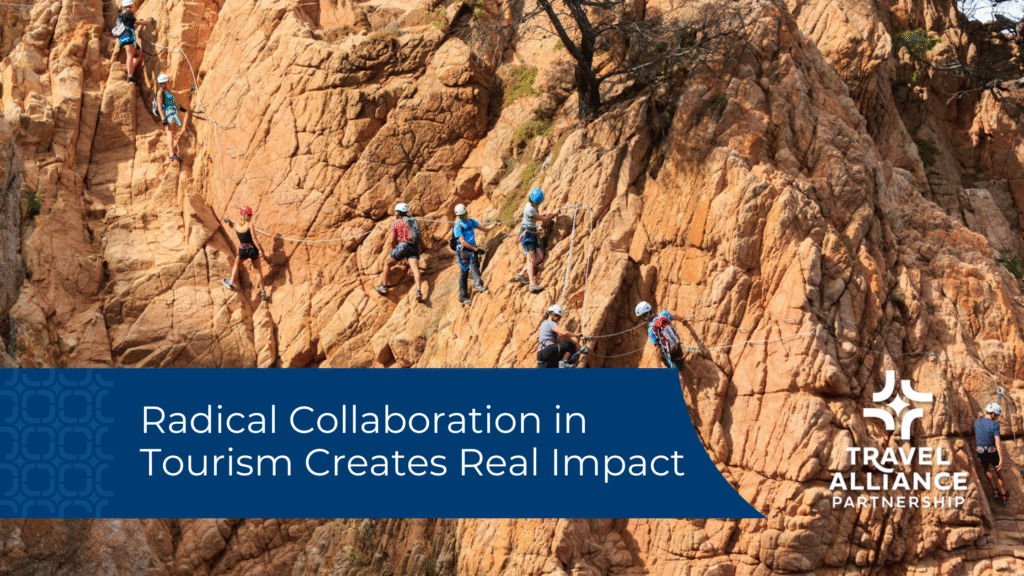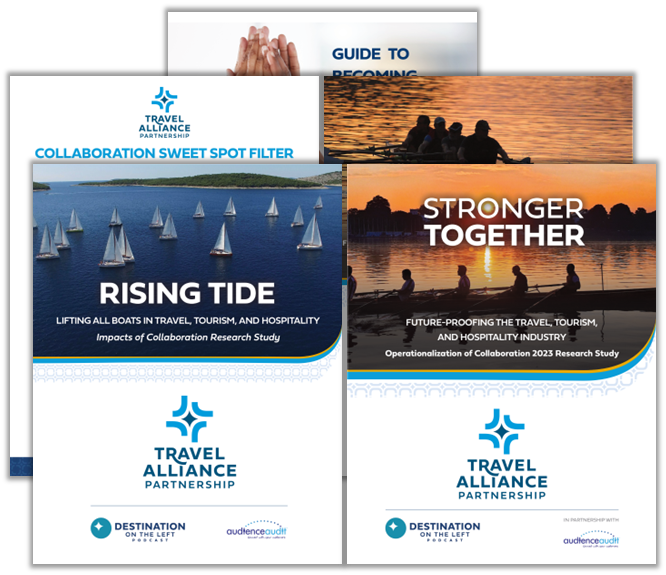Radical Collaboration in Tourism Creates Real Impact
In times of rapid change, collaboration in the travel and tourism industry isn’t just helpful, it’s essential. That message came through loud and clear during our third community conversation of 2025, where three inspiring leaders shared their experiences of working across boundaries, building unlikely partnerships, and redefining what success looks like.
I had the pleasure of hosting this conversation with:
- Dave Herrell, President and CEO of Visit Quad Cities
- Rebecca MacKenzie, President and CEO of the Culinary Tourism Alliance
- Sage Hamilton Hazarika, Corridor Coordinator of Underground Railroad Consortium of New York State
Together, we explored how collaboration is evolving, what it means to have a collaboration mindset, and why the most powerful partnerships often have less to do with money and more to do with trust, vulnerability, and persistence.

Collaboration as the Foundation, Not a Bonus
For some destinations, collaboration is simply the way things get done. Dave Herrell described how it’s woven into the very fabric of his organization:
“We represent 58 communities across two states, Illinois and Iowa. If we are not collaborating on a day-by-day basis and operating in that capacity, then we’re not going to be in the best position to serve our customers and our community.” – Dave Herrell
In the Quad Cities, collaboration isn’t a nice-to-have. It’s a survival strategy for navigating the complexity of multiple municipalities, funding sources, and community needs.
Rebecca MacKenzie echoed that sentiment from a culinary tourism perspective:
“No one single operator could tell a destination’s ‘taste of place’ story. What we do is bring all of those various stakeholders together — from farms and food trucks to fine dining and festivals — to celebrate the culture and history of a place through food and drink.” – Rebecca MacKenzie
Radical Collaboration: Putting Outcomes Over Ego
We also discussed the phrase “radical collaboration,” which Destinations International’s Don Welsh has pointed to as an industry imperative. What does it really mean in practice?
For Sage Hamilton Hazarika, it’s about persistence and values:
“Radical collaboration is digging your heels in and drawing inspiration from your core values. It’s not stopping, despite the indicators that might encourage you otherwise.” – Sage Hamilton Hazarika
Dave took it a step further, challenging us to reframe how we think about ownership and credit:
“It’s about having a mindset that no one cares about who gets the credit. If you come at it from the approach that we’re building a legacy, or beginning with the end in mind, then trust becomes easier and the end results are stronger.” – Dave Herrell
Rebecca connected radical collaboration back to persistence and passion:
“Sometimes our logo isn’t on a project, and that’s okay. The work we’re doing isn’t easy. If it was, everybody would be doing it. Radical collaboration is about not taking no for an answer and just keeping at it.” – Rebecca McKenzie
What stood out is that collaboration is a practice built on trust, vulnerability, and the willingness to put outcomes over ego—where it doesn’t matter who gets the credit, only that the work gets done.
Rethinking How We Measure Success
Traditionally, collaboration in tourism has been measured by economic impact: visitor numbers, spending, and return on investment. But our panelists are pushing those boundaries.
Rebecca shared a powerful example from the Great Taste of Canada Pjila’si Unama’kik Experience on Cape Breton Island. Working with Parks Canada, Indigenous tourism partners, and local organizations, they created an immersive cultural and culinary event rooted in Mi’kmaw heritage.
“One of our biggest successes was realizing that success goes beyond economic impact. It’s about reconciliation, acknowledging cultural protocols, and creating opportunities for Indigenous tourism operators. The testimonials we received afterward were heartwarming and proof that the social and cultural impacts were just as important.” – Rebecca McKenzie
Sage pointed to a different kind of success measure for small organizations like his:
“From being in a small, mostly volunteer-run group, one of the biggest markers of success is even being invited into the conversation. That invitation alone is an achievement, because it means people are starting to recognize the value of what we bring.” – Sage Hamilton Hazarika
These stories remind us that collaboration creates ripples beyond revenue, it fosters community pride, strengthens identity and preserves cultural stories.
Collaboration as the Great Equalizer
One of the most powerful insights from this conversation is that collaboration in tourism levels the playing field. You don’t need a huge budget or a large staff to make an impact when partnerships are strong.
Sage described how the Underground Railroad Consortium, with just one paid staff member and a network of volunteers, is leading the development of a proposed Harriet Tubman Scenic Byway in New York State:
“We worked with tourism partners in Cayuga County and Niagara Falls to develop a 10-year corridor management plan. That project will eventually connect with other state and national byways and it all started with volunteers pooling their knowledge and relationships.” – Sage Hamilton Hazariki
Dave added that the size of a partner’s contribution doesn’t always matter:
“We had a situation where our chamber of commerce couldn’t match our investment in a joint marketing initiative. But we moved forward anyway because it was the right thing for the community. Collaboration isn’t always about equal resources, it’s about shared vision.” – Dave Herrell
Collaboration, in other words, makes space for organizations of every size to contribute meaningfully.
Building Resilience Through Off-Season Innovation
Another theme that surfaced was the role of collaboration in addressing seasonality. Both Rebecca and Dave emphasized the importance of creating year-round experiences.
Rebecca pointed to culinary tourism as a key driver:
“People think harvest is only in the summer, but food experiences exist 365 days a year — from greenhouses to breweries to distilleries. Pairing food with other demand generators is one of the best ways to strengthen off-peak visitation.” – Rebecca MacKenzie
Dave described how Quad Cities leans into its natural assets:
“We’re known as one of the premier places to experience bald eagles in the winter. That’s become a signature event for us, and it not only drives visitation but also supports sustainable tourism and conservation education.” – Dave Herrell
By reimagining challenges like seasonality, collaboration helps destinations stay vibrant year-round.
Key Takeaways for Tourism Professionals
This conversation left me with several powerful takeaways:
- Collaboration is an operating system. For many organizations, it’s the only way to survive and thrive.
- Radical collaboration means humility. Success is about outcomes, not credit.
- Redefine success. Look beyond economic impact to social, cultural, and environmental benefits.
- Partnerships level the playing field. Small organizations can lead big initiatives when networks are strong.
- Resilience comes from creativity. Off-peak innovation strengthens both communities and visitor economies.
As Rebecca reminded us, “The bigger you think beyond the almighty dollar, the better off we all are.”
This forward-focused, candid conversation showed that collaboration in tourism is more than a buzzword. It’s a mindset and a practice that can transform not only our organizations, but also our communities.
Author
Related Posts
Driving Visitation Through Culinary Tourism
When visitors come to a destination, they’re looking for experiences that feel authentic and unforgettable. Few things connect people—or capture the essence of a place—like…
Communication: The 3 C’s of World-Changing Collaborations
Big ideas and big achievements don’t happen alone. They require teamwork and a shared goal. That’s why collaboration is essential, especially in the travel and…
